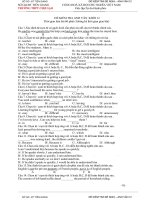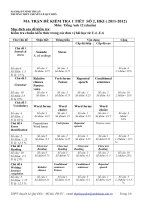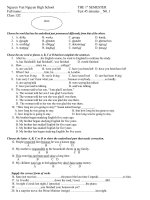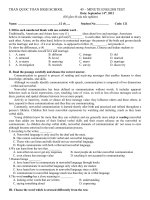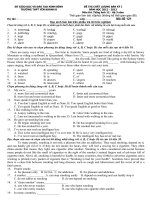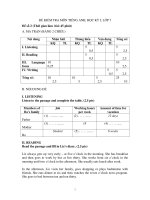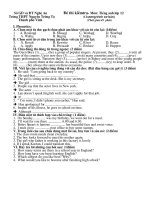Dề kiểm tra môn tiếng anh khối 12
Bạn đang xem bản rút gọn của tài liệu. Xem và tải ngay bản đầy đủ của tài liệu tại đây (121.08 KB, 12 trang )
TRAN QUOC TOAN HIGH SCHOOL 45 – MINUTE ENGLISH TEST
Date: September 14
th
, 2012
(Đề gồm 40 câu trắc nghiệm)
Name: ……………………………………12 cb….. Student No:…………. Code: 121
I. Fill in each numbered blank with one suitable word .
Traditionally, Americans and Asians have very (1)_________ ideas about love and marriage. Americans believe
in romantic marriage- a boy and a girl are(2)_________ to each other, fall in love, and decided to marry each
other. Asians, on the other hand, believe in contractual marriage- the parents of the bride and groom decide on the
marriage; and love –if it ever develops- is supposed to follow (3)_________, not precede it.
To show the differences, a (4)_________was conducted among American, Chinese and Indian students to
determine their attitudes toward love and marriage.
1. A. same B. different C. strange D. old
2. A. attracted B. loved C. handed D. married
3. A. to marry B. marrying C. marry D. marriage
4. A. investigation B. research C. survey D. discovery
II. Read the passage carefully and choose the correct answer.
Communication in general is process of sending and receiving messages that enables humans to share
knowledge, attitudes, and skills.
Although we usually identify communication with speech, communication is composed of two dimensions –
verbal and nonverbal.
Nonverbal communication has been defined as communication without words. It includes apparent behaviors
such as facial expressions, eyes, touching, tone of voice, as well as less obvious messages such as dress, posture
and spatial distance between two or more people.
Activity or inactivity, words or silence all have message value: they influence others and these others, in turn,
respond to these communications and thus they are communicating.
Commonly, nonverbal communication is learned shortly after birth and practiced and refined throughout a
person’s lifetime. Children first learn nonverbal expressions by watching and imitating, much as they learn verbal
skills.
Young children know far more than they can verbalize and are generally more adept at reading nonverbal
cues than adults are because of their limited verbal skills and their recent reliance on the nonverbal to
communicate. As children develop verbal skills, nonverbal channels of communication do’ not cease to exist
although become entwined in the total communication process.
5.According to the writer, ________.
A. Nonverbal language is only used by the deaf and the mute.
B. One cannot communicate in both verbal and .nonverbal language.
C. Those who can listen and talk should not use nonverbal language.
D. People communicate with both verbal and nonverbal language.
6.We can learn from the text that ________.
A. nonverbal can never get any responses B. most people do not like nonverbal communication
C. even silence has message value D. touching is not accepted in communicating
7.Human beings ________.
A. have learnt how to communicate in nonverbal language through books
B. can communicate in nonverbal language only when they are mature
C. have learnt how to communicate in nonverbal language since a child
D. communicate in nonverbal language much less than they do in verbal language
8.The word reading has a close meaning to ________.
A. looking at the words that are written B. understanding
C. saying something aloud D. expressing
III. Choose the word which is stressed differently from the rest.
9.A. situation B. appropriate C. informality D. entertainment
10.A. certain B. couple C. decide D. equal
IV. Choose the word which has the underlined part pronounced differently from the rest.
11.A. appeared B. agreed C. coughed D. ploughed
12.A. cooks B. loves C. enjoys D. spends
V. Choose a, b, c, or d that best completes each unfinished sentence, substitutes the underlined part, or has
a close meaning to the original one.
13.He has been very interested in doing research on _______ since he was at high school.
A. biology B. biological C. biologist D. biologically
14.Most of us would maintain that physical ___________ does not play a major part in how we react to the people
we meet.
A. attract B. attractive C. attractiveness D. attractively
15.Mrs. Pike was so angry that she made a _______ gesture at the driver.
A. rude B. rudeness C. rudely D. rudest
16.- What an attractive hair style you have got, Mary! - _______
A. Thank you very much. I am afraid B. You are telling a lie
C. Thank you for your compliment D. I don’t like your sayings
17. Tom: ____________________________ Lan: Once a year.
A. How often do you go to Da lat? B. How far is it?
C. How do you go to Da lat? D. How long do you go to Dalat?
18.Small children are often told that it is rude to point _______ other people.
A. on B. with C. at D. for
19.It’s hard work looking _______ three children all day.
A. after B. up C. to D. through
20.Mai takes responsibility_________ running the household.
A. up B. at C. in D. for
21.When you see your teacher approaching you, a slight wave to attract his attention is appropriate.
A. coming nearer to B. catching sight of C. pointing at D. looking up to
22.Many young people have objected to____ marriage, which is decided by the parents of the bride and groom.
A. agreed B. shared C. contractual D. sacrificed
23.A woman can never have a happy married life without _______ her husband.
A. demanding B. agreeing C. trusting D.determining
24.Put the raincoat on. It________.
A. had rained B. will be raining C. is raining D. has rained
25.How may times________ them so far?
A. have you seen B. did you see C. were you seeing D. had you seen
26.He found a watch in the street, and then he ________ to return it to the loser.
A. had tried B. was trying C. tried D. had been trying
27.When the doctors________ at the scene of the accident, they ________ victims still ________ .
A. arrived / realized / were breathing B. were arriving / realized / breathed
C. arrived / had realized / breathed D. were arriving / were realizing / were breathing
28.John asked me _______ in English.
A. what does this word mean B. what that word means
C. what did this word mean D. what that word meant
29.Laura said she had worked on the assignment since _______.
A. yesterday B. two days ago C. the day before D. the next day
30.She told the boys _______ on the grass.
A. do not play B. did not play C. not playing D. not to play
31.Jason told me that he _______ his best in the exam the _______ day.
A. had done / following B. will do / previous
C. would do / following D. was going / previous
32.Yesterday, I _______ for work late because I _______ to set my alarm.
A. had left / forgot B. was leaving / was forgetting
C. left / had forgot D. had been leaving / would forget
VI. Choose the sentence which has the closest meaning to the original one.
33.I haven’t seen him for months
A. It’s months since I last saw him B. It’s months when I last saw him
C. It’s months before I last saw him D. It’s months after I last saw him
34.”Did you have a good time abroad?” – She asked me if ________.
A. I have a good time abroad . B. I had good time abroad .
C. I had had a good time abroad . D. I have had a good time abroad .
35.He started working as a teacher five years ago.
A. He has been working as a teacher for five years.
B. He worked as a teacher since five years.
C. He is working as a teacher since five years.
D. He had been working as a teacher for five years
36. “ if I were you, I would go to see the doctor”, David said to Claudia.
A. David asked Claudia not to go to see the doctor.
B. David told Claudia to become a doctor.
C. David advised Claudia to go to see the doctor.
D. David told Claudia that he would go to see the doctor.
VII. identify the one underlined word or phrase – A, B. C or D .
37. He told me that he had met a ghost the day before yesterday.
A B C D
38. Lan has lived in Ho Chi Minh City for 1999.
A B C D
39. After Geogre had returned to his house, he was reading a book.
A B C D
40. What have you do last night?
A B C D
_____the end_____
TRAN QUOC TOAN HIGH SCHOOL 45 – MINUTE ENGLISH TEST
Date: September 14
th
, 2012
(Đề gồm 40 câu trắc nghiệm)
Name: ……………………………………12 cb….. Student No:…………. Code: 122
I. Choose the word which is stressed differently from the rest.
1.A. situation B. informality C. appropriate D. entertainment
2.A. decide B. couple C. certain D. equal
II. Choose the word which has the underlined part pronounced differently from the rest.
3.A. appeared B. agreed C. coughed D. ploughed
4.A. loves B. cooks C. enjoys D. spends
III. Choose a, b, c, or d that best completes each unfinished sentence, substitutes the underlined part, or has
a close meaning to the original one.
5.He has been very interested in doing research on _______ since he was at high school.
A. biologist B. biological C. biology D. biologically
6.Jason told me that he _______ his best in the exam the _______ day.
A. had done / following B. will do / previous
C. would do / following D. was going / previous
7.Yesterday, I _______ for work late because I _______ to set my alarm.
A. had left / forgot B. was leaving / was forgetting
C. left / had forgot D. had been leaving / would forget
8.Most of us would maintain that physical ___________ does not play a major part in how we react to the people
we meet.
A. attract B. attractive C. attractiveness D. attractively
9.Mrs. Pike was so angry that she made a _______ gesture at the driver.
A. rudely B. rudeness C. rude D. rudest
10.What an attractive hair style you have got, Mary! - _______
A. Thank you very much. I am afraid B. Thank you for your compliment
C. You are telling a lie D. I don’t like your sayings
11.It’s hard work looking _______ three children all day.
A. after B. up C. to D. through
12.Mai takes responsibility_________ running the household.
A. up B. at C. in D. for
13.When you see your teacher approaching you, a slight wave to attract his attention is appropriate.
A. coming nearer to B. catching sight of C. pointing at D. looking up to
14.Many young people have objected to____ marriage, which is decided by the parents of the bride and groom.
A. agreed B. shared C. contractual D. sacrificed
15.When the doctors________ at the scene of the accident, they ________ victims still ________ .
A. arrived / realized / were breathing B. were arriving / realized / breathed
C. arrived / had realized / breathed D. were arriving / were realizing / were breathing
16.John asked me _______ in English.
A. what does this word mean B. what that word means
C. what did this word mean D. what that word meant
17.A woman can never have a happy married life without _______ her husband.
A. demanding B. agreeing C. trusting D.determining
18.Put the raincoat on. It________.
A. had rained B. will be raining C. is raining D. has rained
19.How may times________ them so far?
A. had you seen B. did you see C. were you seeing D. have you seen
20.He found a watch in the street, and then he ________ to return it to the loser.
A. had tried B. was trying C. tried D. had been trying
21.Laura said she had worked on the assignment since _______.
A. yesterday B. two days ago C. the day before D. the next day
22.She told the boys _______ on the grass.
A. do not play B. did not play C. not playing D. not to play
23. Tom: ____________________________ Lan: Once a year.
A. How often do you go to Da lat? B. How far is it?
C. How do you go to Da lat? D. How long do you go to Dalat?
24.Small children are often told that it is rude to point _______ other people.
A. on B. at C. with D. for
IV. Choose the sentence which has the closest meaning to the original one.
25.I haven’t seen him for months
A. It’s months since I last saw him B. It’s months when I last saw him
C. It’s months before I last saw him D. It’s months after I last saw him
26. “ if I were you, I would go to see the doctor”,David said to Claudia.
A. David asked Claudia not to go to see the doctor.
B. David told Claudia to become a doctor.
C. David advised Claudia to go to see the doctor.
D. David told Claudia that he would go to see the doctor.
27.”Did you have a good time abroad?” – She asked me if ________.
A. I have a good time abroad . B. I had good time abroad .
C. I had had a good time abroad . D. I have had a good time abroad .
28.He started working as a teacher five years ago.
A. He has been working as a teacher for five years.
B. He worked as a teacher since five years.
C. He is working as a teacher since five years.
D. He had been working as a teacher for five years
V. Identify the one underlined word or phrase – A, B. C or D .
29. He told me that he had met a ghost the day before yesterday.
A B C D
30. What have you do last night?
A B C D
31. Lan has lived in Ho Chi Minh City for 1999.
A B C D
32. After Geogre had returned to his house, he was reading a book.
A B C D
VI. Fill in each numbered blank with one suitable word .
Traditionally, Americans and Asians have very (33)_________ ideas about love and marriage. Americans believe
in romantic marriage- a boy and a girl are(34)_________ to each other, fall in love, and decided to marry each
other. Asians, on the other hand, believe in contractual marriage- the parents of the bride and groom decide on the
marriage; and love –if it ever develops- is supposed to follow (35)_________, not precede it.
To show the differences, a (36)_________was conducted among American, Chinese and Indian students to
determine their attitudes toward love and marriage.
33. A. same B. different C. strange D. old
34. A. handed B. loved C. attracted D. married
35. A. to marry B. marrying C. marry D. marriage
36. A. investigation B. survey C. research D. discovery
VII. Read the passage carefully and choose the correct answer.
Communication in general is process of sending and receiving messages that enables humans to share
knowledge, attitudes, and skills.
Although we usually identify communication with speech, communication is composed of two dimensions –
verbal and nonverbal.
Nonverbal communication has been defined as communication without words. It includes apparent behaviors
such as facial expressions, eyes, touching, tone of voice, as well as less obvious messages such as dress, posture
and spatial distance between two or more people.
Activity or inactivity, words or silence all have message value: they influence others and these others, in turn,
respond to these communications and thus they are communicating.
Commonly, nonverbal communication is learned shortly after birth and practiced and refined throughout a
person’s lifetime. Children first learn nonverbal expressions by watching and imitating, much as they learn verbal
skills.
Young children know far more than they can verbalize and are generally more adept at reading nonverbal
cues than adults are because of their limited verbal skills and their recent reliance on the nonverbal to
communicate. As children develop verbal skills, nonverbal channels of communication do’ not cease to exist
although become entwined in the total communication process.
37.According to the writer, ________.
A. Nonverbal language is only used by the deaf and the mute.
B. One cannot communicate in both verbal and .nonverbal language.
C. Those who can listen and talk should not use nonverbal language.
D. People communicate with both verbal and nonverbal language.
38.We can learn from the text that ________.
A. nonverbal can never get any responses B. most people do not like nonverbal communication
C. even silence has message value D. touching is not accepted in communicating
39.Human beings ________.
A. have learnt how to communicate in nonverbal language through books
